Acoustic Environment and Noise Exposure in Fitness Halls
Abstract
1. Introduction
2. Methods
2.1. Characteristics of Studied IS & G Halls
2.2. Noise Level Measurements in IS & G Halls
2.3. Reverberation Time Measurements
2.4. Case-Study Simulation Application
2.5. Interviews and Questionnaire
| Part 1: General information |
| Age: ____________ Gender: □ Male □ Female c. Are you: □ Instructor □ Participant d. Time spent in gym □ One hour □Two hours □ Three hours □ Four hours □ Five hours and more |
| Part 2: Hearing and Acoustic Environment |
| 1. Do you have any hearing problems? □ Yes □ No 2. How would you describe the listening conditions (sound clarity and loudness)? □ Very satisfied □ Satisfied □ Fair □ Unsatisfied □ Very Unsatisfied 3. How would you describe the sound in the gym? □ Do not know □ Do not feel reverberance and echo □ Fair □ Feel reverberance and echo □ Feel strong reverberance and echo 4. How would you evaluate the loud music during workout sessions? □ Very motivating □ Motivating □ Fair □ Stressful □ Very stressful 5. How would you rate the background noise level? □ Not annoyed at all □ Not annoyed □ Fairly annoyed □ Annoyed □ Very annoyed 6. How would you rate the overall acoustic environment in the fitness hall? □ Very comfortable □ Comfortable □ Fair □ Uncomfortable □ Very uncomfortable |
3. Results and Discussion
3.1. Noise Levels and Noise Exposure
3.2. Reverberation Time
3.3. Cases-Study Simulation Application
3.4. Subjective Evaluation of IS & G Acoustics
3.5. Subjective Evaluation of IS & G Hall Acoustics and its Relationship to Measured Values
4. Conclusions and Recommendations
Funding
Acknowledgments
Conflicts of Interest
References
- Building Bulletin. Acoustic Design of Schools: Performance Standards; The National Archives London: London, UK, 2015. [Google Scholar]
- Gómez Escobar, V.; Barrigón Morillas, J.M. Analysis of intelligibility and reverberation time recommendations in educational rooms. Appl. Acoust. 2015, 96, 1–10. [Google Scholar] [CrossRef]
- Labia, L.; Shtrepi, L.; Astolfi, A. Improved Room Acoustics Quality in Meeting Rooms: Investigation on the Optimal Configurations of Sound-Absorptive and Sound-Diffusive Panels. Acoustics 2020, 2, 25. [Google Scholar] [CrossRef]
- Hodgson, M.; Steininger, G.; Razavi, Z. Measurement and prediction of speech and noise levels and the Lombard e ect in eating establishments. J. Acoust. Soc. Am. 2007, 121, 2023–2033. [Google Scholar] [CrossRef] [PubMed]
- Lane, H.; Tranel, B. The Lombard Sign and the Role of Hearing in Speech. J. Speech Hear. Res. 1971, 14, 677–709. [Google Scholar] [CrossRef]
- Zucki, F.; Lacerda, A.B.M. The noise in physical education activities. In Hearing Health-Risk Assessment and Prevention, 1st ed.; Plexus: São Paulo, Brazil, 2010. [Google Scholar]
- Elliott, D.; Carr, S.; Orme, D. The effect of motivational music on sub-maximal exercise. Eur. J. Sport Sci. 2005, 5, 97–106. [Google Scholar] [CrossRef]
- Edworthy, J.; Waring, H. The effects of music tempo and loudness level on treadmill exercise. Ergonomics 2006, 49, 1597–1610. [Google Scholar] [CrossRef] [PubMed]
- Karageorghis, C.I.; Priest, D. Music in the exercise domain: A review and synthesis (Part I). Int. Rev. Sport Exerc. Psychol. 2012, 5, 44–66. [Google Scholar] [CrossRef]
- John, G.W.; Grynevych, A.; Welch, D.; McBride, D.; Thorne, P.R. Noise exposure of workers and the use of hearing protection equipment in New Zealand. Arch. Environ. Occup. Health 2014, 69, 69–80. [Google Scholar] [CrossRef]
- Darby, N.A.M.; Brueck, E.J. Noise Exposure of Physical Education, Music, and Craft, Design and Technology Teachers; Health and Safety Laboratory: Buxton, UK, 2001. [Google Scholar]
- Conetta, R.; Shield, B.; Cox, T.; Mydlarz, C.; Dockrell, J.; Connolly, D. Acoustics of indoor sports halls and gymnasia. Gymnasium 2012, 40, 1–5. [Google Scholar]
- Jiang, T. Risks of noise-induced hearing loss for physical education teachers. J. Occup. Environ. Med. 1997, 39, 925–926. [Google Scholar] [CrossRef]
- Masullo, M.; Lenzuni, P.; Maffei, L.; Nataletti, P.; Ciaburro, G.; Annesi, D.; Moschetto, A. Assessment of noise exposure for basketball sports referees. J. Occup. Environ. Hyg. 2016, 13, 464–475. [Google Scholar] [CrossRef] [PubMed]
- Maffei, L.; Iannace, G.; Masullo, M.; Nataletti, P. Noise exposure in school gymnasia and swimming pools. Noise Control. Eng. J. 2009, 57, 603–612. [Google Scholar] [CrossRef]
- Torre, P., III; Howell, J. Noise levels during aerobics and the potential effects on distortion product otoacoustic emissions. J. Commun. Disord. 2008, 41, 501–511. [Google Scholar] [CrossRef] [PubMed]
- Yaremchuk, K.; Kaczor, J. Noise levels in the health club setting. Ear Nose Throat J. 1999, 78, 54–57. [Google Scholar] [CrossRef]
- Lia, K.; Anjelo, H.; Henrique, P.; Zannin, T. Résumé 1 Introduction Canadian Acoustics/Acoustique canadienne. Can. Acoust. Acoust. Can. 2015, 43, 19–24. [Google Scholar]
- Piotr Pękala, P.L. Reverberation noise exposure in Polish school gyms. Arch. Acoust. 2005, 30, 209–212. [Google Scholar]
- Nie, V.; Beach, E. Fitness Instructors and Noise Exposure: Spreading the Hearing Health Message. Acoust. Aust. 2016, 44, 87–93. [Google Scholar] [CrossRef]
- Jonsdottir, V.I. Connection between unfavourable acoustics in sports halls and high prevalence of voice problems in sport teachers. In Proceedings of the Euronoise 2009, Edinburgh, UK, 26–28 October 2009. [Google Scholar]
- Fontan, L.; Fraval, M.; Michon, A.; Déjean, S.; Welby-Gieusse, M. Vocal Problems in Sports and Fitness Instructors: A Study of Prevalence, Risk Factors, and Need for Prevention in France. J. Voice 2017, 31, 261.e33–261.e38. [Google Scholar] [CrossRef]
- Astolfi, A.; Bottalico, P.; Accornero, A.; Garzaro, M.; Nadalin, J.; Giordano, C. Relationship between vocal doses and voice disorders on primary school teachers. In Proceedings of the European Conference on Noise Control, Prague, Czech Republic, 10–13 June 2012; pp. 55–60. [Google Scholar]
- Zhao, F.; Manchaiah, V.K.; French, D.; Price, S.M. Music exposure and hearing disorders: An overview. Int. J. Audiol. 2010, 49, 54–64. [Google Scholar] [CrossRef]
- Schmidt, J.H.; Pedersen, E.R.; Paarup, H.M.; Christensen-Dalsgaard, J.; Andersen, T.; Poulsen, T.; Bælum, J. Hearing Loss in Relation to Sound Exposure of Professional Symphony Orchestra Musicians. Ear Hear. 2014, 35, 448–460. [Google Scholar] [CrossRef]
- Susan, L.; Henrich, V.C.; Mace, S.T. Prevalence of noise-induced hearing loss in student musicians. Int. J. Audiol. 2010, 49, 309–316. [Google Scholar] [CrossRef]
- Beach, E.; Gilliver, M.; Williams, W. Leisure noise exposure: Participation, trends, symptoms of hearing damage and perceptions of risk. Int. J. Audiol. 2013, 52, 20–25. [Google Scholar] [CrossRef] [PubMed]
- Hee, S.; Jik, P.; Ho, J. E ff ects of noise sensitivity on psychophysiological responses to building noise. Build. Environ. 2018, 136, 302–311. [Google Scholar] [CrossRef]
- Puglisi, G.E.; Astolfi, A.; Cutiva, L.C.C.; Carullo, A. Assessment of indoor ambient noise level in school classrooms. In Proceedings of the 10th European Congress and Exposition on Noise Control Engineering, Euronoise, Maastricht, The Netherlands, 31 May–3 June 2015; pp. 715–720. [Google Scholar]
- Greier, K.; Drenowatz, C.; Ruedl, G.; Riechelmann, H. Noise Exposure of Physical Education Teachers—Empirical Study Using Measurement of Sound Pressure Level (SPL). J. Health Sci. Educ. 2018, 2, 1–6. [Google Scholar] [CrossRef]
- Mei, H.; Kang, J. An experimental study of the sound field in a large atrium. Build. Env. 2012, 58, 91–102. [Google Scholar] [CrossRef]
- Chen, X.; Kang, J. Acoustic comfort in large dining spaces. Appl. Acoust. 2017, 115, 166–172. [Google Scholar] [CrossRef]
- Wang, C.; Ma, H.; Wu, Y.; Kang, J. Characteristics and prediction of sound level in extra-large spaces. Appl. Acoust. 2018, 134, 1–7. [Google Scholar] [CrossRef]
- Ananthaganeshan, K.A.; Gastmeier, W.J. Acoustical Performance Criteria, Treatment and Guidelines for Multifunctional School Gymnasia. Can. Acoust. 2007, 35, 25–30. [Google Scholar]
- NIOSH. Criteria for a Recommended Standard Occupational Noise Exposure, National Institute for Occupational Safety and Health; NIOSH: Washington, DC, USA, 1998. [Google Scholar]
- ISO 1999:2013 International Organization for Standardization (ISO). Acoustics—Determination of Occupational Noise Exposure and Estimation of Noise Induced Hearing Impairment (Standard No. ISO 1999:2013); ISO: Geneva, Switzerland, 2013. [Google Scholar]
- European Union. European Union Directive 2002/49/EC relating to the assessment and management of environmental noise (END). Off. J. Eur. Commun. 2002, 12–25. [Google Scholar] [CrossRef]
- MOPWH. Jordanian Acoustic Code, Ministry of Public Works and Housing, Jordan National Building Council JNBC; MOPWH: Amman, Jordan, 2019. [Google Scholar]
- Martin, B. Specialty fitness centre noise issues—Case study. J. Acoust. Soc. Am. 2018, 144, 1788. [Google Scholar] [CrossRef]
- Dokmeci, P.N.; Kang, J. Objective parameters for acoustic comfort in enclosed spaces. In Proceedings of the 20th International Congress on Acoustics, ICA 2010, Sydney, Australia, 23–27 August 2010; Volume 5, pp. 3488–3491. [Google Scholar]
- South, T. Managing Noise and Vibration at Work; Elsevier Butterworth-Heinemann: Oxford, UK, 2004; ISBN 0750663421. [Google Scholar]
- Gastmeier, W.J.; Aitken, D.R. Reverberation Time in Gymnasia. J. Can. Acoust. Assoc. 1999, 27, 3–7. [Google Scholar]
- Maekawa, Z.; Rindel, J.H.; Lord, P. Environmental and Architectural Acoustics, 2nd ed.; Taylor and Francis Group: Abingdon-on-Thames, UK, 2010; ISBN 13: 978-0-203-93135-6. [Google Scholar]
- Kuttruff, H. Room Acoustics, 6th ed.; CRC Press (Taylor and Francis): Boca Raton, FL, USA, 2017; ISBN 0-203-18623-0. [Google Scholar]
- ISO 3382-2. International Organization for Standardization (ISO), Acoustics-Mesurement of Room Acoustic Parameters—Part 2: Reverberation Time in Ordinary Room; ISO: Geneva, Switzerland, 2016. [Google Scholar]
- Rhinoceros 3D User Documentation. Available online: http://docs.mcneel.com/rhino/6/usersguide/en-us/index.htm (accessed on 29 August 2020).
- Microsoft Visual Studio, Programming Using Csharp. Available online: https://docs.microsoft.com/en-us/visualstudio/get-started/csharp/visual-studio-ide?view=vs-2019 (accessed on 29 August 2020).
- RhinoCommon (Dynamic Link Library), Tamplate Using Microsoft Visual Studio. Available online: https://marketplace.visualstudio.com/items?itemName=McNeel.RhinoCommontemplatesforv6 (accessed on 29 August 2020).
- Matplotlib User Documentation. Available online: https://matplotlib.org/3.3.1/contents.html (accessed on 29 August 2020).
- Grasshopper 3D in Rhinoceros3D (Python) Developer Documentation. Available online: https://developer.rhino3d.com/guides/rhinopython/ (accessed on 29 August 2020).
- PedSIM Plugin in Grasshopper. Available online: https://www.pedsim.net/pedsim/ (accessed on 29 August 2020).
- Nvidia Developer. PhysX and Fluid Simulation (Smart Particles). Available online: https://developer.nvidia.com/particles (accessed on 29 August 2020).
- Web Absorption Data (English). Available online: http://www.acoustic.ua/st/web_absorption_data_eng.pdf (accessed on 29 August 2020).
- Chen, J.; Ma, H. An impact study of acoustic environment on users in large interior spaces. Build. Acoust. 2019, 26, 139–153. [Google Scholar] [CrossRef]
- Dökmeci, P.N.; Yýlmazer, S. Relationships between Measured Levels and Subjective Ratings: A Case Study of the Food-Court Area in CEPA Shopping Center, Ankara. Build. Acoust. 2012, 19, 57–73. [Google Scholar] [CrossRef]
- Meng, Q.; Kang, J. Influence of Social and Behavioural Characteristics of Users on their Evaluation of Subjective Loudness and Acoustic Comfort in Shopping Malls. PLoS ONE 2013, 8, e54497. [Google Scholar] [CrossRef]
- Al-arja, O.A.; Awadallah, T.S. Assessment of occupational noise exposure in coffee grinding shops. Appl. Acoust. 2020, 158, 107047. [Google Scholar] [CrossRef]
- EPA. Environmental Protection Agency Report; EPA: Washington, DC, USA, 1974. [Google Scholar]
- Shaikh, G.H. Occupational noise exposure limits for developing countries. Appl. Acoust. 1999, 57, 89–92. [Google Scholar] [CrossRef]
- Cranston, J.C.; Brazile, W.J.; Sandfort, D.R.; Gotshall, R.W. Occupational and recreational noise exposure from indoor arena hockey games. J. Occup. Environ. Hyg. 2013, 10, 11–16. [Google Scholar] [CrossRef]
- Nowos’wiat, A.; Olechowska, M. Fast estimation of speech transmission index using the reverberation time. Appl. Acoust. 2016, 102, 55–61. [Google Scholar] [CrossRef]
- World Health Organization. In Proceedings of the WHO Technical Meeting on Exposure Response Relationships of Noise on Health, Bonn, Germany. 2003. Available online: https://windfarmrealities.org/wp-content/uploads/wfr-docs/who-technical-meeting-noise-health-2002.pdf (accessed on 11 September 2020).
- Sanavi, A.; Schäffer, B.; Heutschi, K.; Eggenschwiler, K. On the Effect of an Acoustic Diffuser in Comparison with an Absorber on the Subjectively Perceived Quality of Speech in a Meeting Room. Acta Acust. United Acust. 2017, 103, 1037–1049. [Google Scholar] [CrossRef]
- Alnuman, N.; Ghnimat, T. Awareness of Noise-Induced Hearing Loss and Use of Hearing Protection among Young Adults in Jordan. Int. J. Environ. Res. Public Health 2019, 16, 2961. [Google Scholar] [CrossRef]
- Alnuman, N.; Altaweel, M.Z. Investigation of the acoustical environment in a shopping mall and its correlation to the acoustic comfort of the workers. Appl. Sci. 2020, 10, 1170. [Google Scholar] [CrossRef]
- Bottalico, P.; Passione, I.I.; Graetzer, S.; Hunter, E.J. Evaluation of the starting point of the Lombard Effect. Acta Acust United Acust. 2017, 103, 169–172. [Google Scholar] [CrossRef] [PubMed]
- Meng, Q.; Kang, J.; Jin, H. Field study on the influence of spatial and environmental characteristics on the evaluation of subjective loudness and acoustic comfort in underground shopping streets. Appl. Acoust. 2013, 74, 1001–1009. [Google Scholar] [CrossRef]

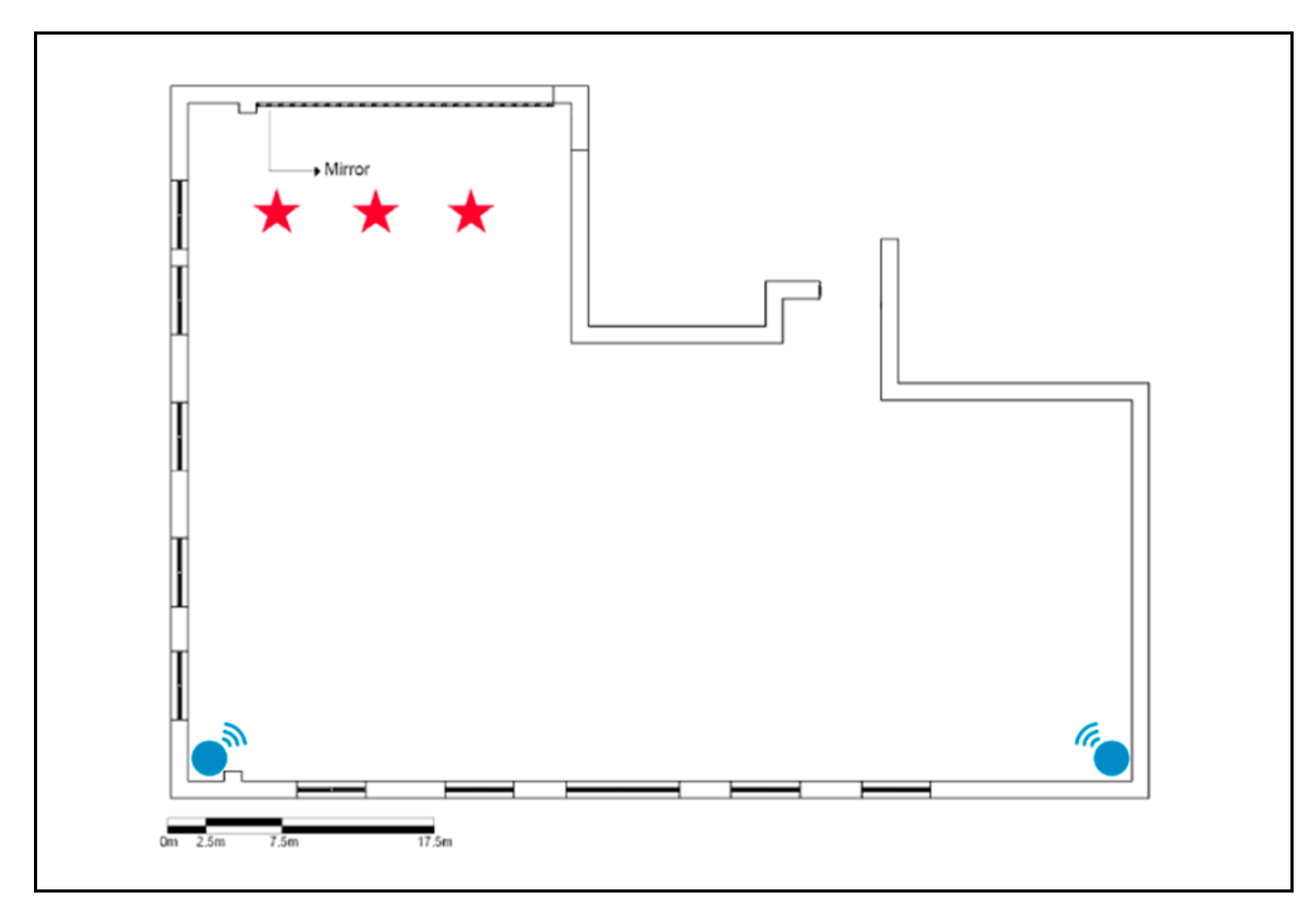
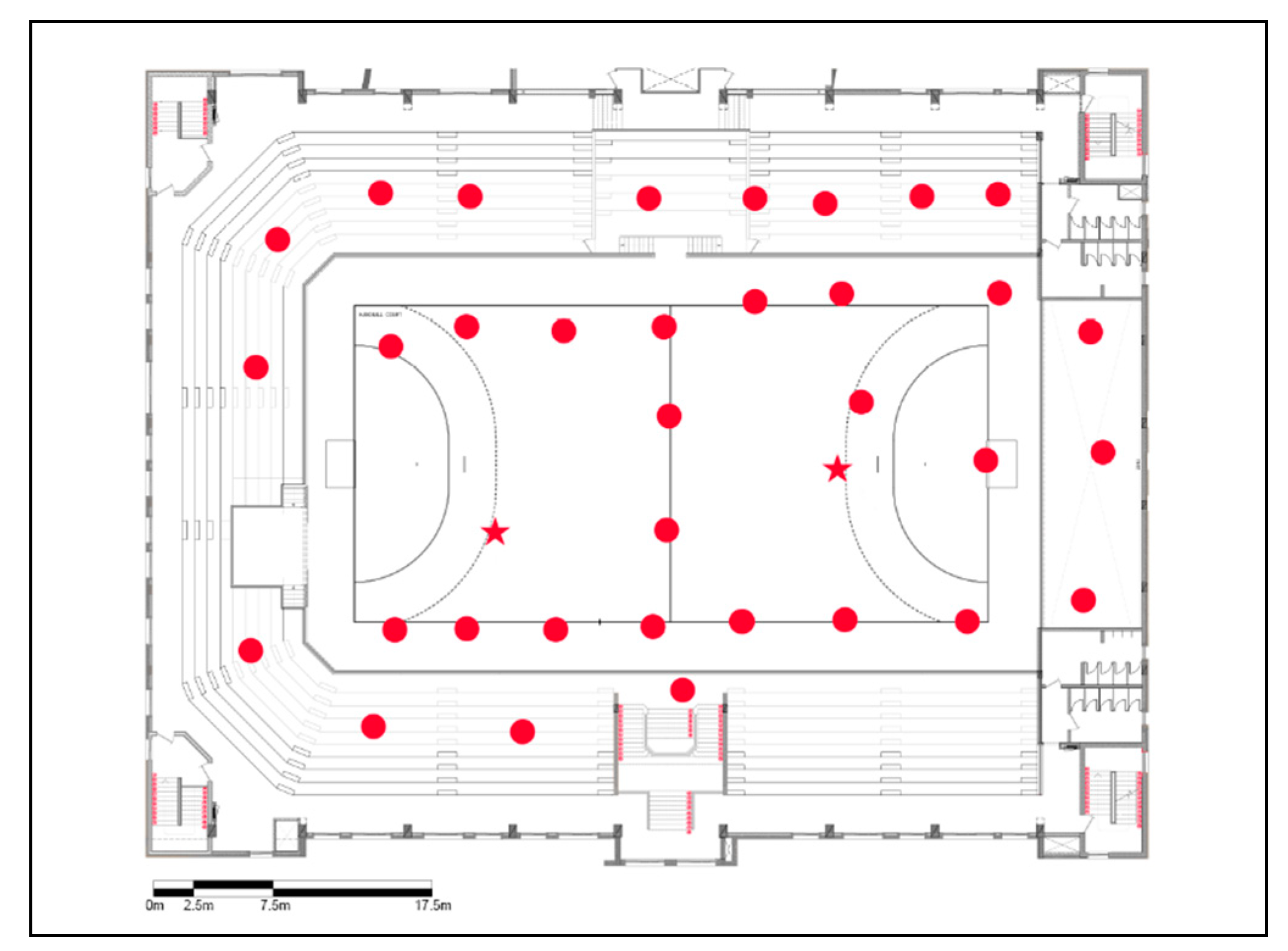
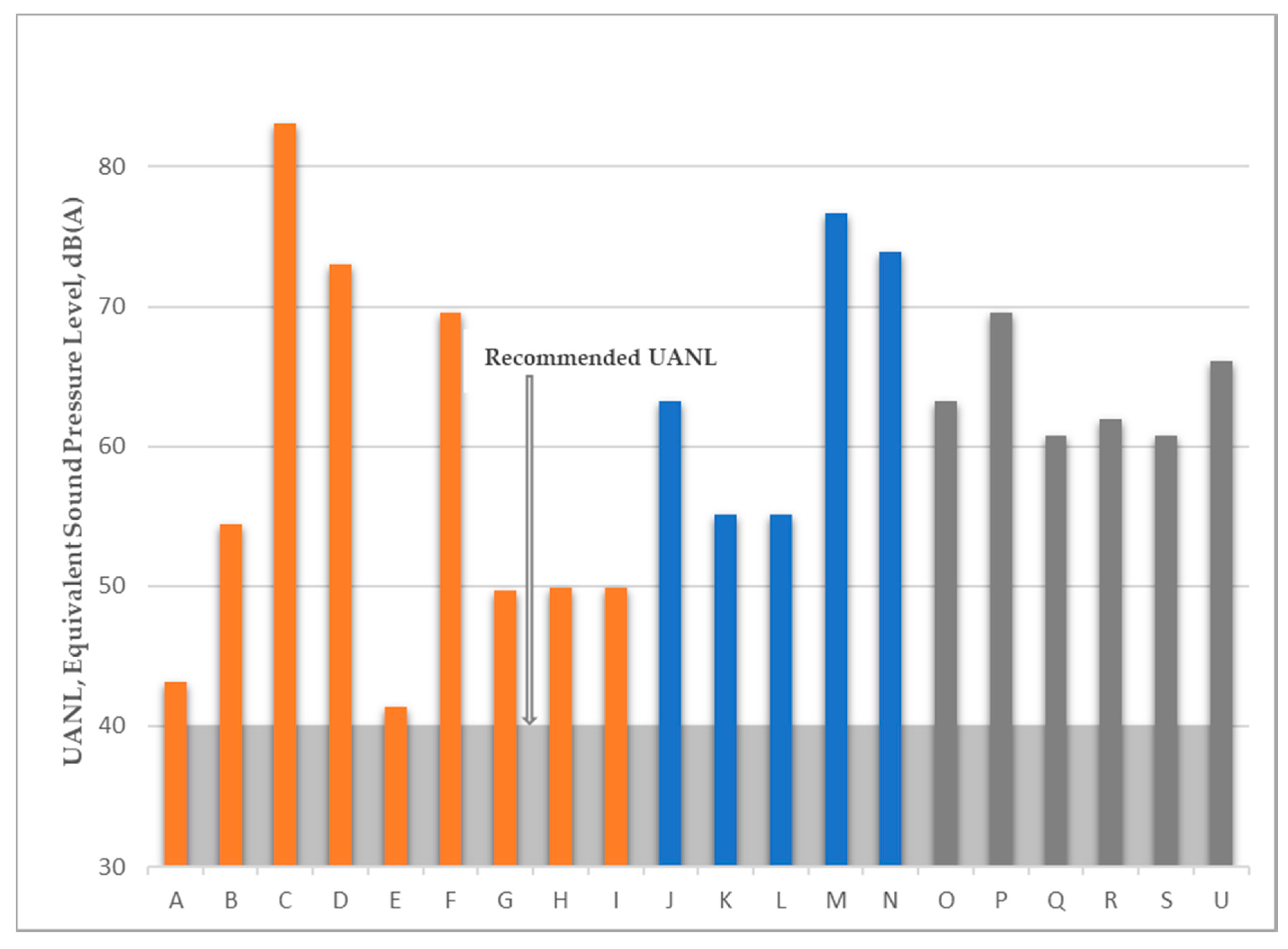
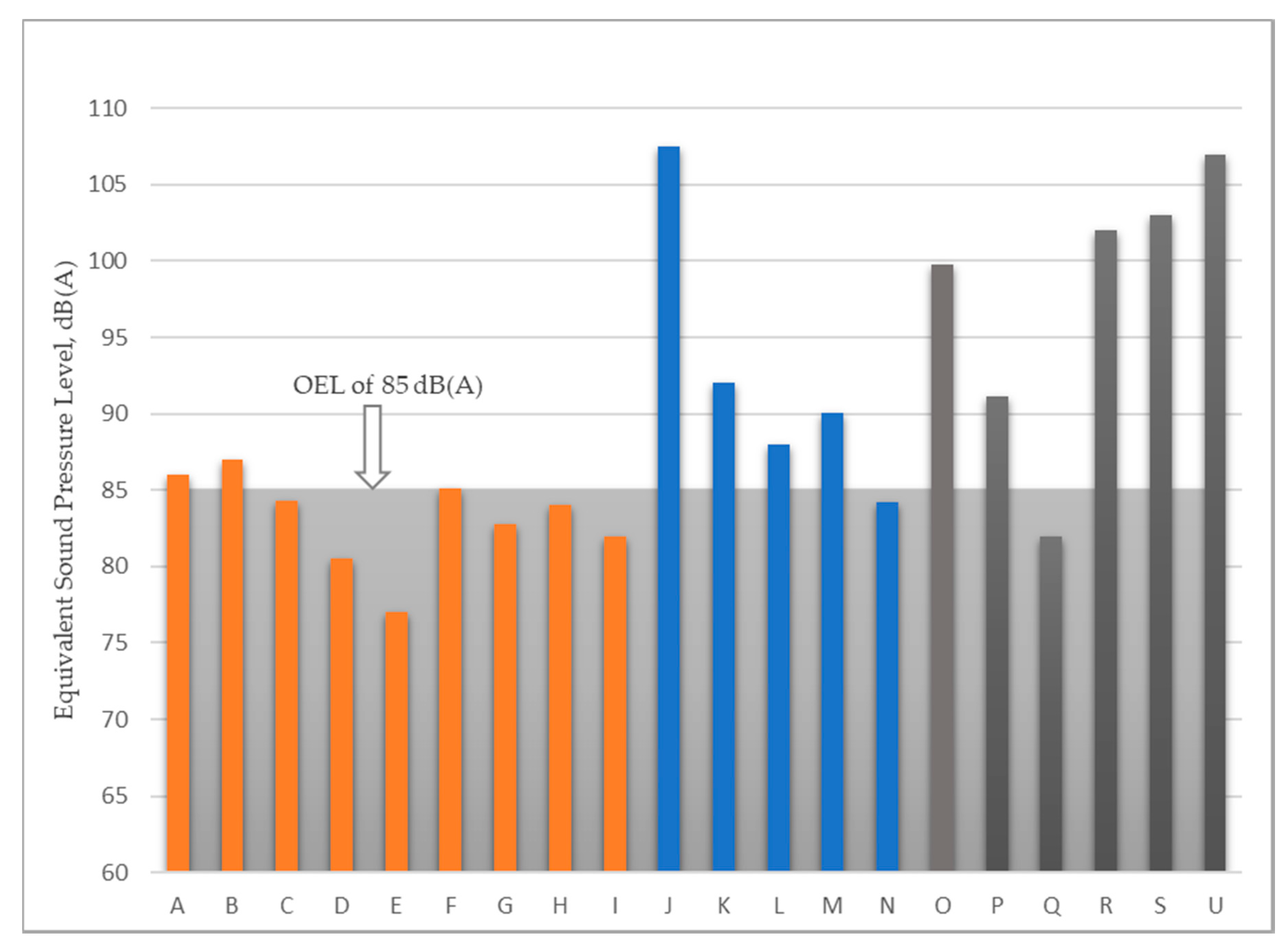
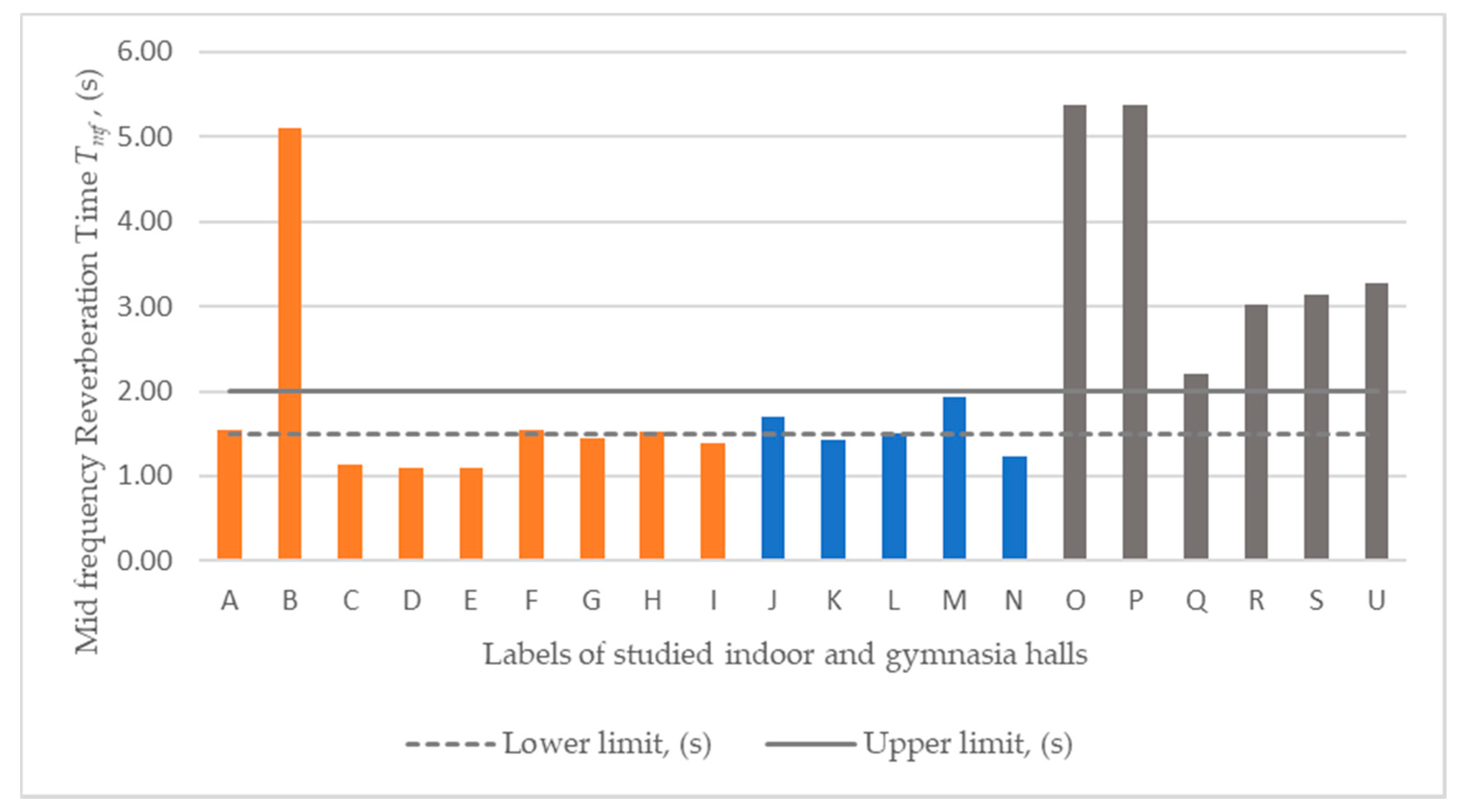
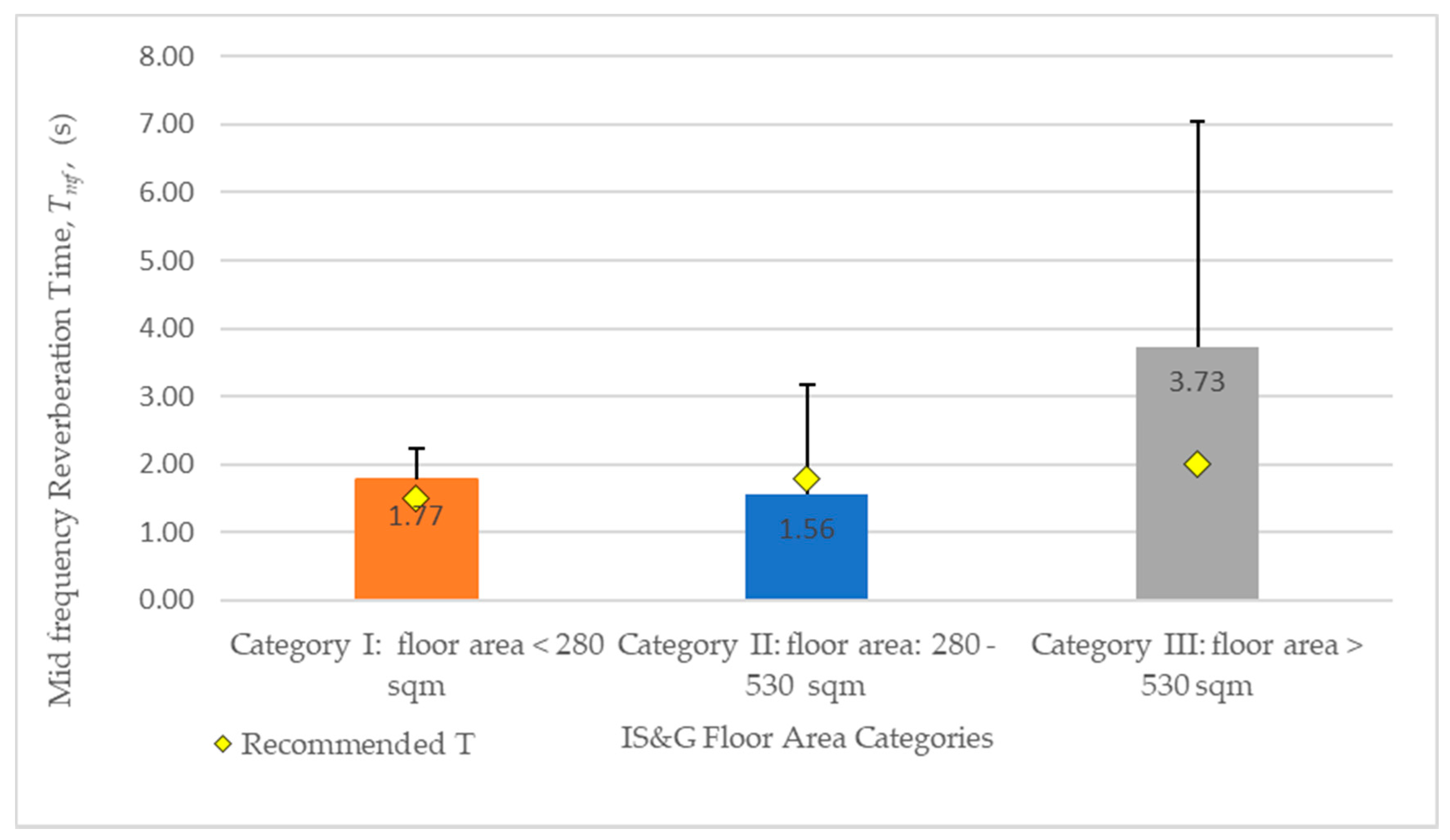
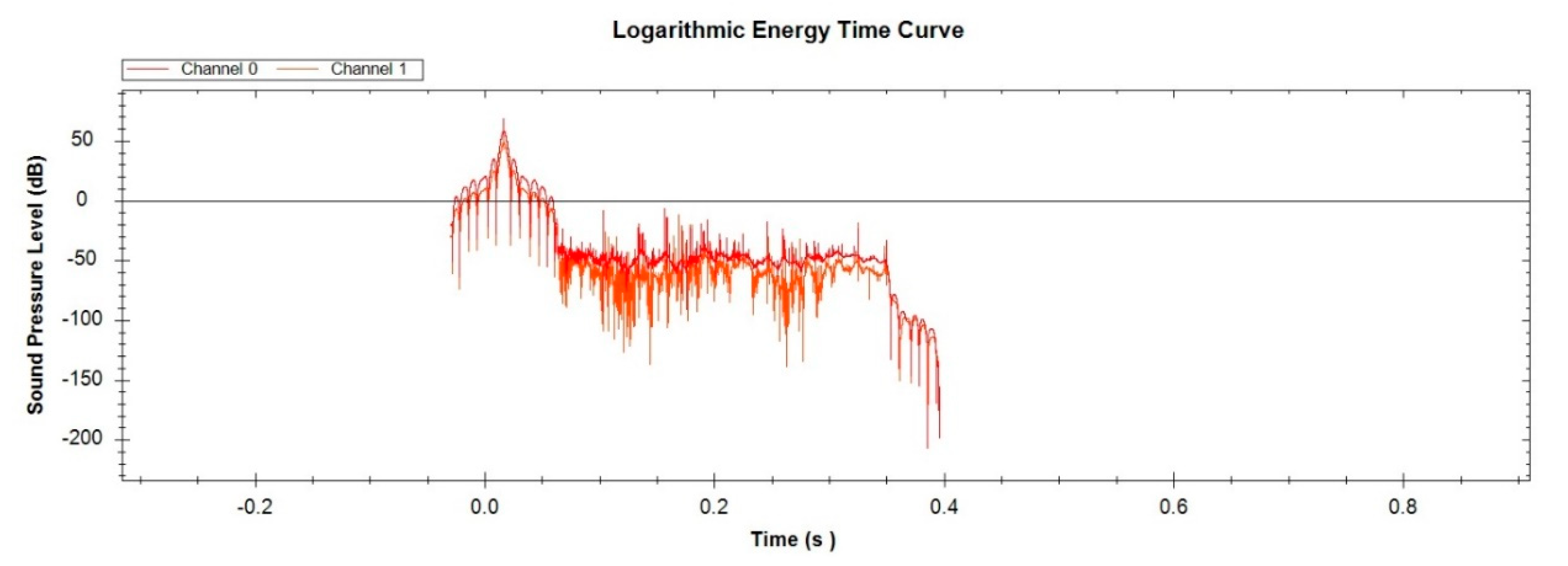

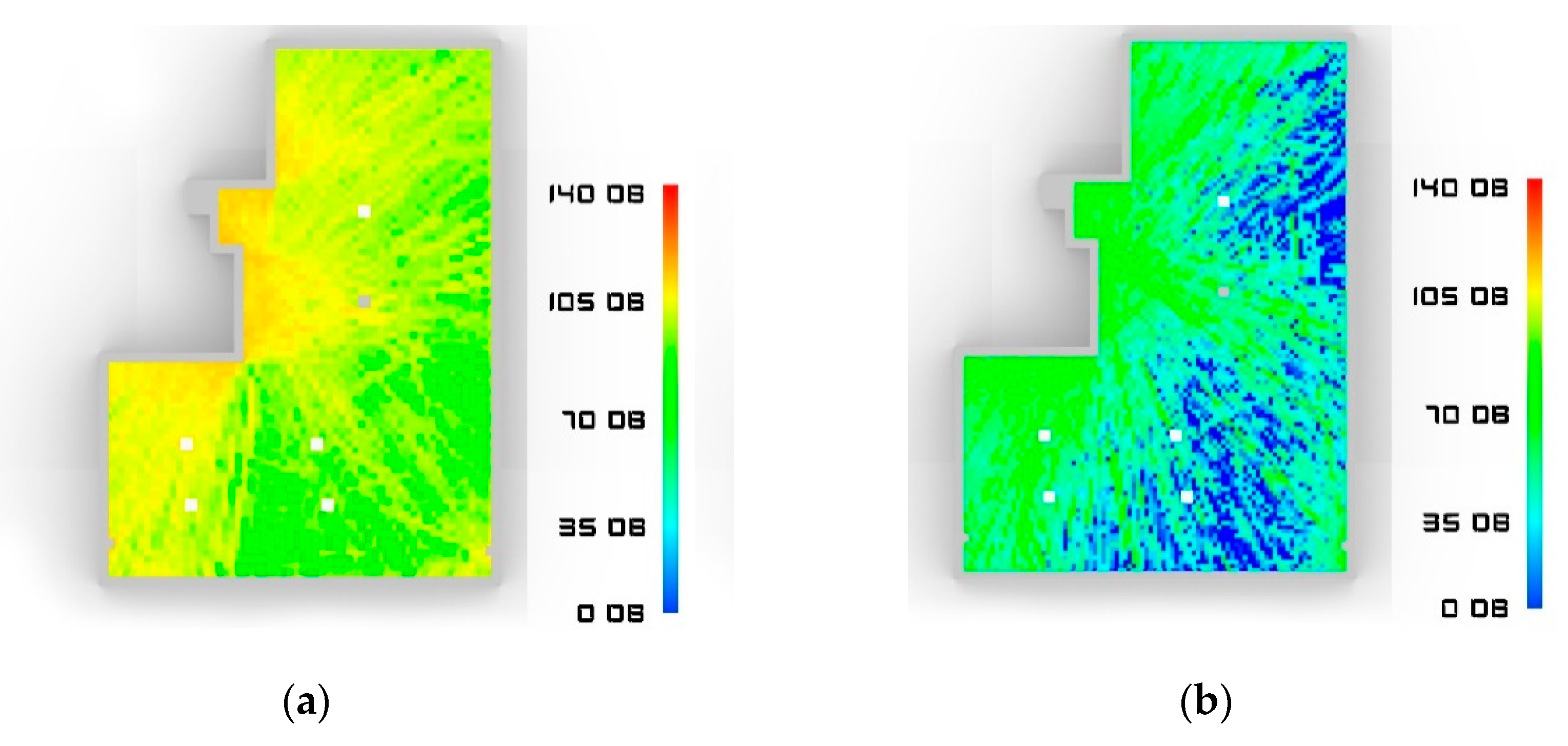
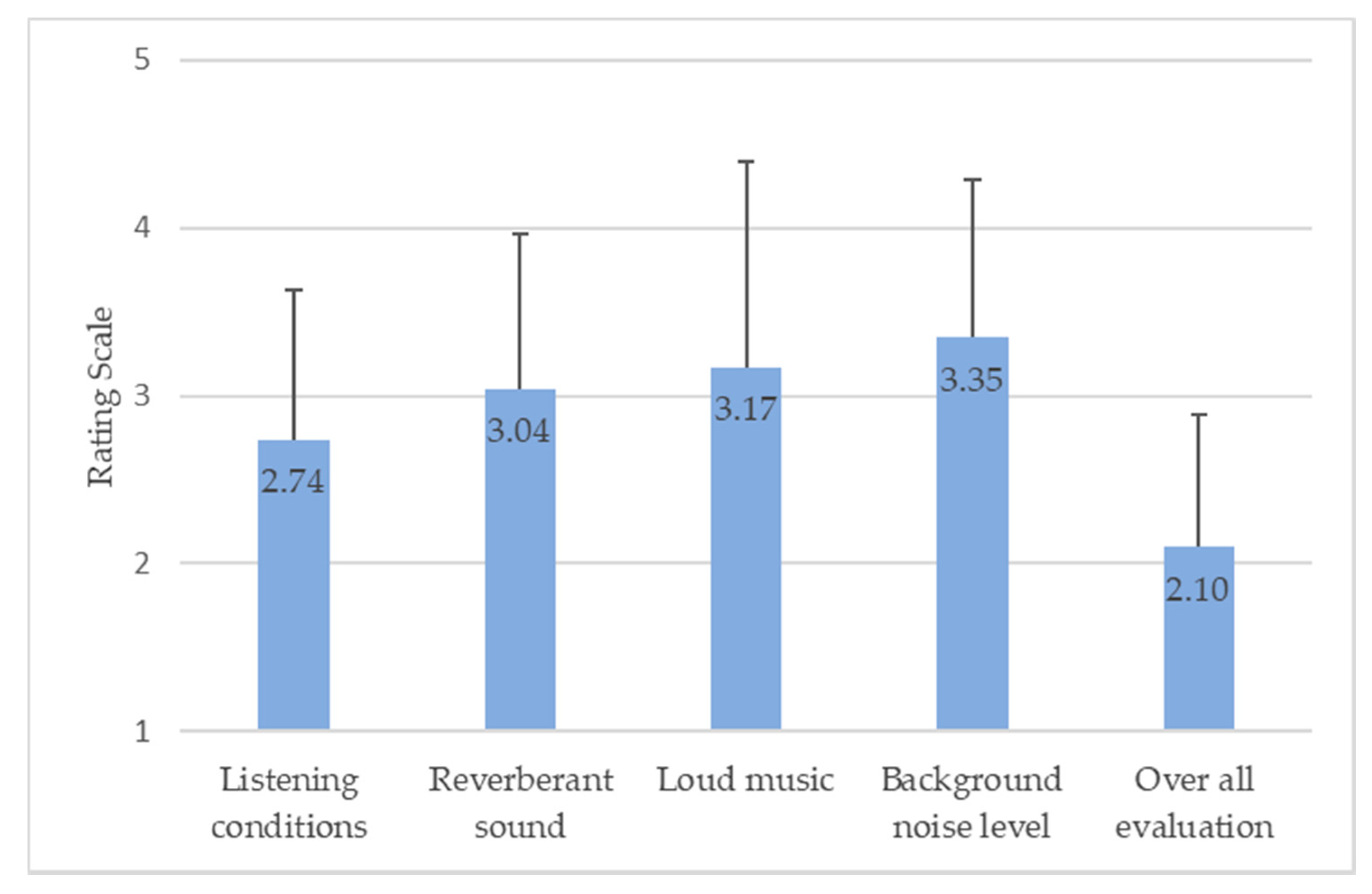
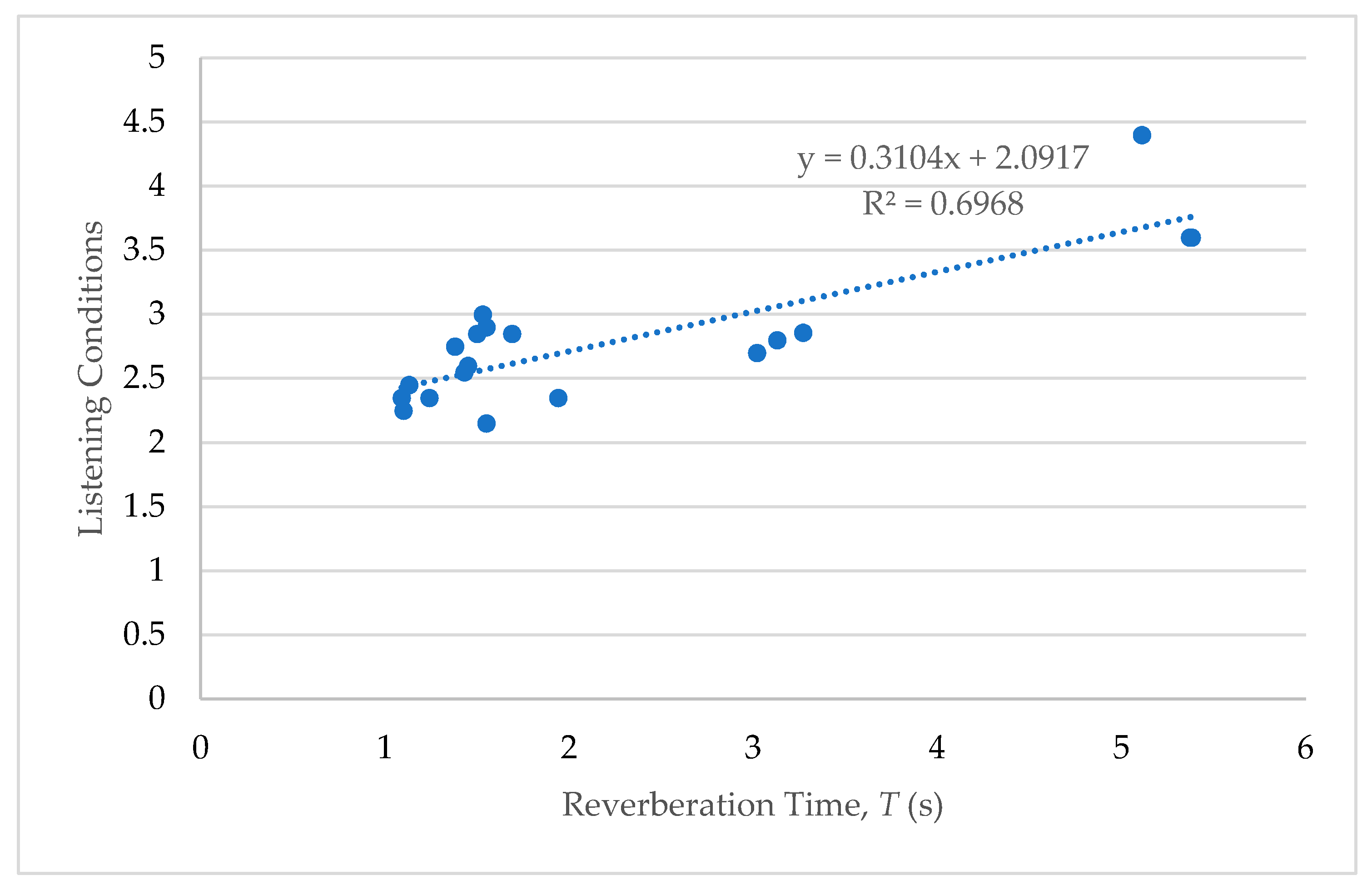

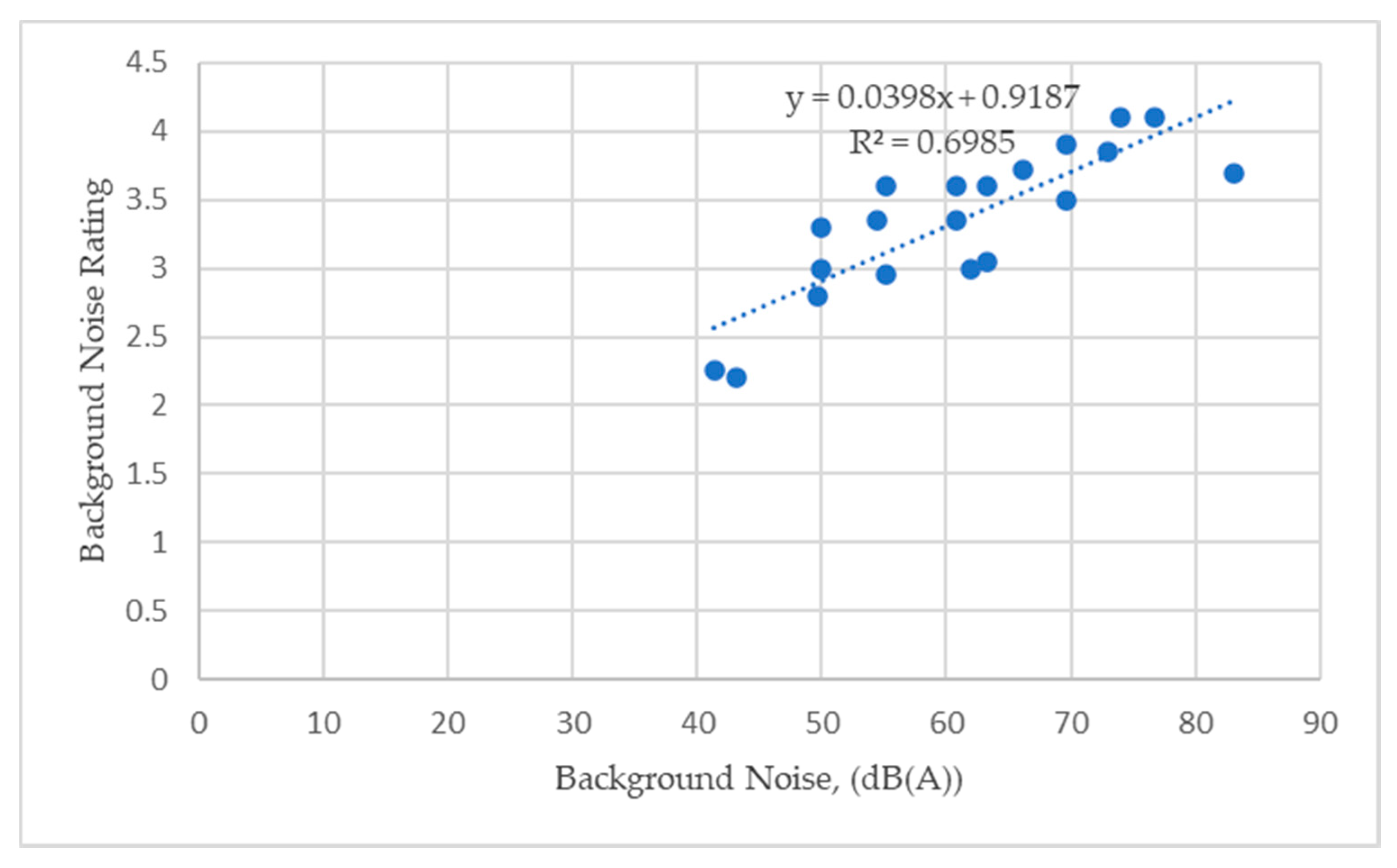
| No. | IS & G Hall | Material Used in Interior Design | ||
|---|---|---|---|---|
| Floor | Ceiling | Walls | ||
| 1 | A | W ** | GB * | CP * |
| 2 | B | EP * | CP * | CP * |
| 3 | C | W ** | CP * | CP * |
| 4 | D | W ** | GB * | CP * |
| 5 | E | V ** | GB * | CP * |
| 6 | F | P ** | GB * | CP * |
| 7 | G | W ** | MD * | G * |
| 8 | H | W ** | AT ** | G & CP * |
| 9 | I | W ** | CP * | CP & G * |
| 10 | J | V ** | GB * | CP & G * |
| 11 | K | W ** | GB * | CP * |
| 12 | L | W ** | CP * | CP * |
| 13 | M | F ** | CP * | CP * |
| 14 | N | F ** | CP * | CP & G * |
| 15 | O | EC * | MD * | G * |
| 16 | P | EC * | GB * | G & CP * |
| 17 | Q | EC * | AT ** | CP * |
| 18 | R | F ** | MD * | G & P * |
| 19 | S | V ** | MD * | G & P * |
| 20 | U | F ** | MD * | G & P * |
| Material | 125 (Hz) | 250 (Hz) | 500 (Hz) | 1000 (Hz) | 2000 (Hz) | 4000 (Hz) |
|---|---|---|---|---|---|---|
| Cement plastering | 0.02 | 0.02 | 0.03 | 0.04 | 0.05 | 0.05 |
| Gypsum boards | 0.45 | 0.70 | 0.80 | 0.80 | 0.65 | 0.45 |
| Epoxy on concrete | 0.10 | 0.25 | 0.65 | 0.55 | 0.70 | 0.70 |
| Wrapped panels and baffles | 0.25 | 0.74 | 1.50 | 1.80 | 1.50 | 0.98 |
| No. | Fitness Hall | Indoor Ambient Noise Level, 30 min LA,eq (dB(A)) | LA,eq (dB(A)) 50 min Workout Session | LAFmax (dB(A)) | LAFmin (dB(A)) | Daily Noise Dose D (%) Te = 50 min (Workout Session Duration) | Daily Noise Dose D (%) Te = 3 h (or 180 min (Mean Daily Exposure Time) | Personal Daily Dose A-Weighting LEX, 8 h (dB(A)) |
|---|---|---|---|---|---|---|---|---|
| 1 | A | 43.0 | 89.0 | 98.0 | 46.0 | 26.2 | 78.6 | 86.0 * |
| 2 | B | 55.0 | 90.0 | 83.0 | 50.0 | 32.8 | 98.4 | 87.0 * |
| 3 | C | 83.0 | 85.0 * | 102.0 | 56.0 | 16.6 | 49.8 | 84.0 |
| 4 | D | 73.0 | 83.0 | 88.0 | 70.0 | 8.4 | 25.2 | 81.0 |
| 5 | E | 42.0 | 80.0 | 83.0 | 50.0 | 3.2 | 9.6 | 77.0 |
| 6 | F | 70.0 | 88.0 | 92.0 | 70.0 | 20.8 | 62.4 | 85.0 |
| 7 | G | 50.0 | 86.0 | 103.0 | 50.0 | 13.2 | 39.6 | 83.0 |
| 8 | H | 50.0 | 87.0 | 105.0 | 51.0 | 16.6 | 49.8 | 84.0 |
| 9 | I | 50.0 | 85.0 | 77.0 | 46.0 | 10.4 | 31.2 | 82.0 |
| 10 | J | 63.0 | 111.0 | 141.0 | 62.0 | >>100 | >>100 | 108.0 * |
| 11 | K | 55.0 | 95.0 | 110.0 | 57.0 | 105.2 | 315.6 | 92.0 * |
| 12 | L | 55.0 | 91.0 | 106.0 | 53.0 | 41.6 | 124.8 | 88.0 * |
| 13 | M | 77.0 | 93.0 | 89.0 | 69.0 | 66.2 | 198.6 | 90.0 * |
| 14 | N | 74.0 | 87.0 | 89.0 | 56.0 | 16.6 | 49.8 | 84.0 |
| 15 | O | 63.0 | 103.0 | 111.0 | 58.0 | >>100 | >>100 | 100.0 * |
| 16 | P | 70.0 | 94.0 | 104.0 | 67.0 | 83.4 | 250.2 | 91.0 * |
| 17 | Q | 61.0 | 85.0 | 92.0 | 75.0 | 10.4 | 31.2 | 82.0 |
| 18 | R | 62.0 | 105.0 | 130.0 | 55.0 | >>100 | >>100 | 102.0 * |
| 19 | S | 61.0 | 106.0 | 132.0 | 58.0 | >>100 | >>100 | 103.0 * |
| 20 | U | 66.0 | 110.0 | 135.0 | 60.0 | >>100 | >>100 | 107.0 * |
| Type of Room | Upper Limit for Indoor Ambient Noise Level LEX, 8 h | |
|---|---|---|
| New Building | Refurbishment | |
| Indoor sports hall | 40.0 | 45.0 |
| Gymnasium/activity studio | 40.0 | 45.0 |
| LAEP,d | LCpeak | |
|---|---|---|
| Lower exposure action value | 80 dB | 135 dB or 112 Pa |
| Upper exposure action value | 85 dB | 137 dB or 140 Pa |
| Exposure limit value | 87 dB | 140 dB or 200 Pa |
| No. | Fitness Hall | Area | Volume | T (s) | Tmf (s) | Recommended Tmf, (s) | |||
|---|---|---|---|---|---|---|---|---|---|
| 500 Hz | 1000 Hz | 2000 Hz | |||||||
| 1 | Category I | A | 72 | 180 | 1.25 | 1.75 | 1.65 | 1.55 (±0.26) | 1.5 |
| 2 | B | 62 | 311 | 6.25 | 4.95 | 4.13 | 5.11 (±1.07) | ||
| 3 | C | 54 | 270 | 1.01 | 1.1 | 1.28 | 1.13 (±0.14) | ||
| 4 | D | 134 | 338 | 0.99 | 1.11 | 1.17 | 1.09 (±0.09) | ||
| 5 | E | 140 | 456 | 0.99 | 1.13 | 1.17 | 1.10 (±0.09) | ||
| 6 | F | 110 | 275 | 1.03 | 2.29 | 1.33 | 1.55 (±0.66) | ||
| 7 | G | 66 | 264 | 1.25 | 1.41 | 1.7 | 1.45 (±0.23) | ||
| 8 | H | 70 | 280 | 1.28 | 1.44 | 1.86 | 1.53 (±0.30) | ||
| 9 | I | 80 | 347 | 1.48 | 1.36 | 1.3 | 1.38 (±0.09) | ||
| 10 | Category II | J | 367 | 1100 | 1.82 | 1.45 | 1.79 | 1.69 (±0.21) | 1.67 * |
| 11 | K | 410 | 1435 | 1.15 | 1.5 | 1.63 | 1.43 (±0.25) | 1.76 * | |
| 12 | L | 421 | 1475 | 1.39 | 1.56 | 1.56 | 1.50 (±0.10) | 1.78 * | |
| 13 | M | 516 | 2305 | 1.92 | 1.98 | 1.92 | 1.94 (±0.03) | 1.97 * | |
| 14 | N | 416 | 1858 | 1.09 | 1.25 | 1.39 | 1.24 (±0.15) | 1.77 * | |
| 15 | Category III | O | 840 | 8653 | 5.1 | 5.49 | 5.54 | 5.38 (±0.24) | 2.0 |
| 16 | P | 828 | 8530 | 4.98 | 5.54 | 5.6 | 5.37 (±0.34) | ||
| 17 | Q | 2531 | 25,792 | 2.13 | 2.31 | 2.16 | 2.20 (±0.10) | ||
| 18 | R | 1200 | 9000 | 2.86 | 3.21 | 2.98 | 3.02 (±0.18) | ||
| 19 | S | 1230 | 9225 | 3.05 | 3.3 | 3.05 | 3.13 (±0.14) | ||
| 20 | U | 1260 | 10,005 | 3.16 | 3.47 | 3.18 | 3.27 (±0.17) | ||
| Parameter | Instructors (n = 137) | Participants (n = 264) | p-Value | ||
|---|---|---|---|---|---|
| Mean | SD | Mean | SD | ||
| Listening conditions | 2.64 | ±0.855 | 2.78 | ±0.908 | 0.131 |
| Reverberant sound | 3.13 | ±0.906 | 2.99 | ±0.935 | 0.155 |
| Loud music | 2.05 | ±0.869 | 3.75 | ±0.937 | p < 0.01 |
| Background noise level | 3.31 | ±0.782 | 3.37 | ±1.012 | 0.539 |
| Overall evaluation | 2.52 | ±0.796 | 1.88 | ±0.687 | p < 0.01 |
© 2020 by the author. Licensee MDPI, Basel, Switzerland. This article is an open access article distributed under the terms and conditions of the Creative Commons Attribution (CC BY) license (http://creativecommons.org/licenses/by/4.0/).
Share and Cite
Al-Arja, O.A. Acoustic Environment and Noise Exposure in Fitness Halls. Appl. Sci. 2020, 10, 6349. https://doi.org/10.3390/app10186349
Al-Arja OA. Acoustic Environment and Noise Exposure in Fitness Halls. Applied Sciences. 2020; 10(18):6349. https://doi.org/10.3390/app10186349
Chicago/Turabian StyleAl-Arja, Omaimah Ali. 2020. "Acoustic Environment and Noise Exposure in Fitness Halls" Applied Sciences 10, no. 18: 6349. https://doi.org/10.3390/app10186349
APA StyleAl-Arja, O. A. (2020). Acoustic Environment and Noise Exposure in Fitness Halls. Applied Sciences, 10(18), 6349. https://doi.org/10.3390/app10186349




